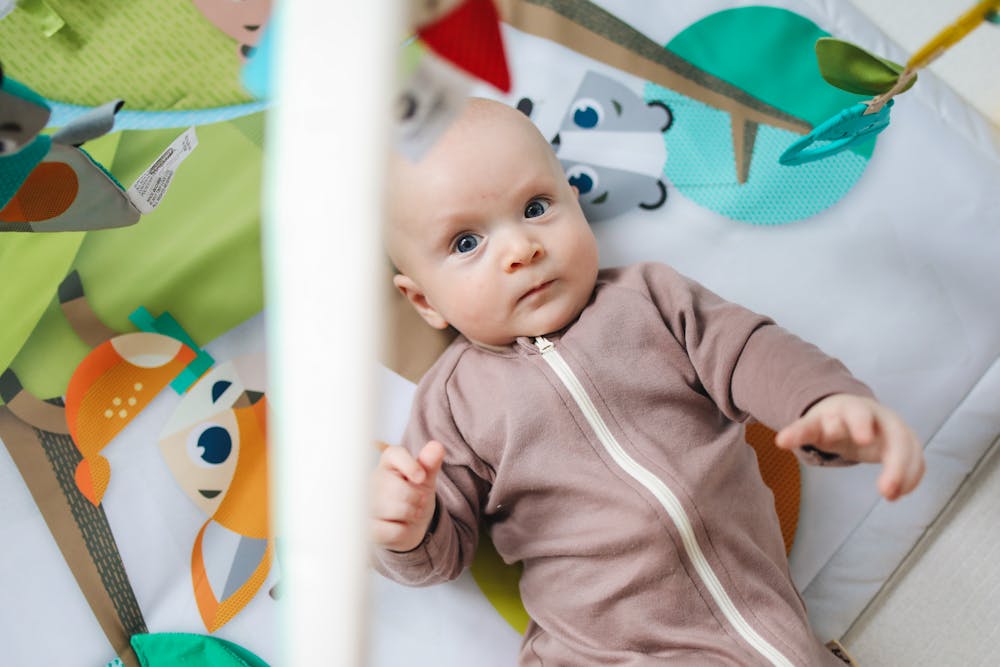Featured
Picking the perfect play mat for a newborn can seem challenging with all the choices available. One key aspect to consider is the material of the mat. Choosing mats made from hypoallergenic and non-toxic materials ensures safety and comfort for your baby. For eco-conscious parents, options like a linen play mat for newborns provide a natural and breathable surface for play.
The design and features of a playmat also play an important role in your decision. Some mats offer vibrant colours and patterns that can engage your baby’s senses. Additionally, mats with extra features like detachable toys can improve interaction and playtime.
For practicality, look for mats that are easy to clean or machine washable to make your life easier. Incorporating these elements can transform any play area into a safe and delightful space for your little one.
Understanding Newborn Needs
Caring for a newborn involves making sure they are comfortable, safe, and given opportunities to grow. Understanding these needs helps parents choose the right items for their baby, such as a play mat that supports comfort, safety, and development.
The Importance of Comfort
Comfort is important for a newborn’s well-being. Babies need soft and soothing materials that keep them relaxed. A play mat should have a plush surface that is gentle on the baby’s skin. Cotton or fleece materials are commonly used because they are soft and breathable.
These fabrics help in keeping the baby warm during colder months and cool during warmer periods. The cushioning on a play mat provides support for a newborn’s delicate back and shoulders, making tummy time enjoyable. An easy-to-clean surface is important, too. Spills and accidents are common, so mats with machine-washable covers are convenient for parents. The baby’s comfort during playtime should always be prioritized to promote peaceful interaction with their surroundings.

Safety Considerations
Safety is a top priority for newborns. When picking a play mat, parents need to consider several factors. First, guarantee that the mat is non-toxic and free from harmful chemicals. Materials like BPA, lead, and phthalates should be avoided. Some play mats are made with organic materials, indicating they are safe for the environment and for babies.
Another consideration is slip resistance. A mat should have a non-slip backing to prevent it from sliding across the floor. This reduces the risk of injuries. Additionally, check the edges of the mat. They should be smooth and well-sewn to avoid any loose threads or sharp parts that could pose a threat. Keeping all these aspects in mind helps create a safe play environment for the baby.
Sensory Development Factors
Newborns are constantly learning from their surroundings. A play mat can help boost their sensory development. Look for mats with varied textures to stimulate the baby’s sense of touch. Bright colours and patterns can capture their attention, encouraging their visual development. Some play mats come with attached toys or sections that crinkle or rattle, providing auditory stimulation.
These elements encourage babies to explore and discover. Mirrors and hanging toys let babies practice reaching and grabbing, aiding their motor skills. Overall, a thoughtfully chosen play mat can support a baby in seeing, hearing, touching, and moving. It’s important to align these features with the baby’s developmental stage to keep them engaged and curious.
5 Tips for Choosing the Right Play Mat
Picking the perfect play mat for a newborn involves focusing on several key aspects that guarantee safety, comfort, and fun for the baby. Important factors include the type of material, ease of cleaning, size, visual appeal, and portability.

Material and Durability
The material of the play mat is important for safety and comfort. Non-toxic materials like organic cotton or safe foam should be considered. This helps create a safe space for babies to play and explore. The durability of the material is also important, as the mat should withstand regular use and cleaning. Mats with a textured surface can help with grip and stability, providing a safer area for babies during tummy time and play sessions.
Ease of Cleaning
Babies are messy, so ease of cleaning is important when choosing a play mat. Some mats are machine washable, making them convenient for busy parents. Others have a wipeable surface, which is great for quick clean-ups. Stain-resistant materials can help maintain the appearance of the mat over time. It’s a good idea to check the cleaning instructions before purchasing to guarantee that the mat will be easy to maintain.
Appropriate Size and Shape
The size and shape of the mat can affect how often and where it is used. Larger mats offer more space for movement and play, but they may not fit in smaller rooms. Smaller mats are easier to move but might not provide enough area for babies as they grow. It’s useful to measure the space where the mat will be used to guarantee a good fit. Some mats also come in puzzle pieces, allowing for customizable sizing.
Visual Appeal and Features
Play mats often come with different patterns and colors, which can stimulate a baby’s senses. Bright colors and entertaining designs are appealing, but some parents may prefer more neutral tones that blend with home decor. Features like textured surfaces, mirrors, or attached toys can provide extra entertainment and developmental benefits. It’s important that any added features are securely attached to the mat to prevent choking hazards.
Portability and Storage
Portability can be an advantage if the mat will be used in different locations. Some mats can be folded or rolled, making them easy to transport. Lightweight designs are easier to carry, while some play mats come with carrying cases for added convenience. For those with limited storage space, foldable or rollable mats that can be tucked away when not in use are a smart choice.

Conclusion
Choosing the perfect pay mat for a newborn involves considering several important factors. First, the material of the mat should be soft and safe for the baby’s skin. Look for hypoallergenic options to prevent irritation.
The size of the mat is also important. It should fit well in the room where it will be used and provide enough space for the baby to move.
It’s helpful to select a mat that is easy to clean. Babies often spill, so having a mat that’s simple to wipe down or throw in the wash can save time.
Safety is key. The mat should have a non-slip bottom to prevent accidents and ensure the child’s comfort and security.
Lastly, choose a portable mat if you plan to move it around the house or take it when traveling. This flexibility allows the baby to have a familiar place to play wherever they are.
Photo Credit: Pexels.com





























